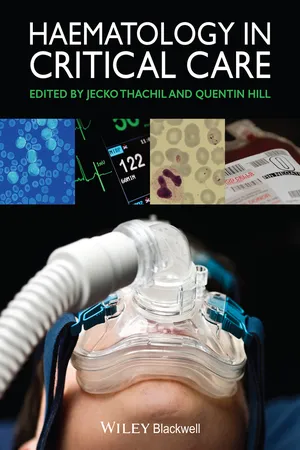
- English
- ePUB (mobile friendly)
- Available on iOS & Android
About This Book
Issues of thrombosis, bleeding, and transfusion are extremely common, and often complex, in critically ill patients.
Haematology in Critical Care: A Practical Handbook providesa dependable source of expert guidance on how to handle common haematological problems seen in the critical care setting, as well as the acute care of patients with a primary haematological disorder.
Full-time clinical haematologists, regularly attending on intensive care, the Editors begin with an approach to abnormal laboratory tests, following with a disease-orientated approach to topics such as coagulation and haematological malignancy. Other key topics include paediatric and neonatal care, transfusion, point of care testing and the emergency presentation of haematological disease.
This title brings together two of the most highly scientific specialties in clinical practice, delivering a practical approach to these problems, and guiding the clinician through the diagnosis and management of common scenarios encountered in the ICU.
Frequently asked questions
Information
Section 1
Approach to Abnormal Blood Tests
Chapter 1
Diagnostic Approach to Anaemia in Critical Care
Diagnostic approach to anaemia in critical care
- If there is a sudden unexpected drop in Hb, this may be a sampling error; consider repeating the full blood count (FBC).
- Is the anaemia acute or chronic? This may inform the diagnosis, likely tolerance of anaemia and treatment strategy. Only 10–15% of ICU patients have chronic anaemia prior to admission [4].
- Is the anaemia isolated or are there other cytopenias? Thrombocytopenia (Chapter 3) is also a common finding (~40% of ICU patients) and will therefore often coexist with anaemia in critically ill patients. Common causes of both include sepsis, organ failure and acute blood loss, but important differentials include disseminated intravascular coagulation (DIC) (Chapter 9) and thrombotic microangiopathies (TMAs) (Chapter 11). Review the clotting and blood film. Haemophagocytic lymphohistiocytosis (HLH) is an important cause of fever and cytopenias that can present with single or multiple organ failure (see succeeding text under extrinsic causes of extravascular haemolysis).
- Pancytopenia may be an artefact (i.e. dilution during sampling) or result from BM failure or infiltration, infection, HLH, hypersplenism, drugs, autoimmune disease or megaloblastic anaemia. If pancytopenia is present, examine for splenomegaly and request a blood film and haematinics. If the cause remains unclear, the advice of a haematologist should be sought as a BM examination may be required.

Normocytic anaemia (MCV within the normal range)
Microcytic anaemia (MCV below the normal range)
Table of contents
- Cover
- Title page
- Copyright page
- List of Contributors
- Preface
- Acknowledgements
- Section 1: Approach to Abnormal Blood Tests
- Section 2: Approach to Coagulation Problems
- Section 3: Approach to Transfusion Problems
- Section 4: Approach to Red Cell Problems
- Section 5: Approach to White Cell Problems
- Section 6: Admission to Intensive Care
- Section 7: Point-of-Care Testing
- Section 8: Haematology Drugs in Critical Care
- Section 9: Haematology in Paediatric and Neonatal Intensive Care
- Section 10: Haematological Emergencies
- Appendix A: Adult, Paediatric and Neonatal Haematology Reference Intervals
- Index
- End User License Agreement